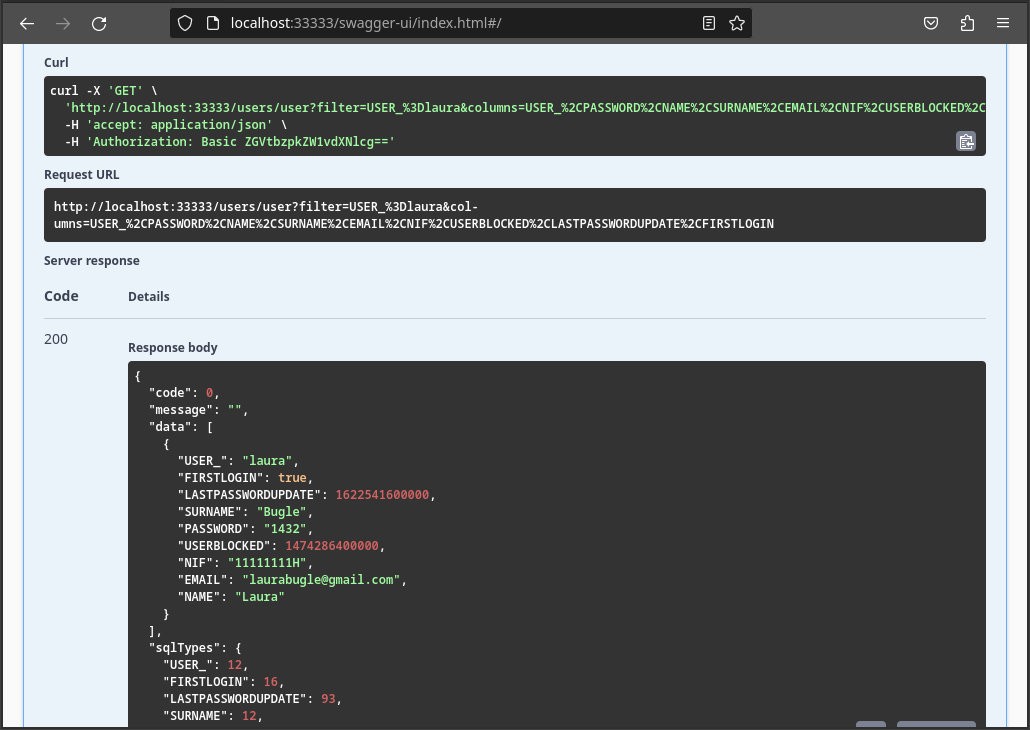OpenAPI System using Ontimize REST controllers
Introduction
Ontimize OpenAPI Generator allows you to generate, from the interface files, the API code for Ontimize REST controllers.
Prerequisites
There are 2 options to follow this tutorial, clone the repository with the initial state and follow the tutorial step by step, or download the final example and see which files are new and which have been updated.
Initial project
/$ git clone https://github.com/ontimize/ontimize-examples
/ontimize-examples$ cd ontimize-examples
/ontimize-examples$ git checkout boot-openapi-ontimize-controllers-initial
Final example
/$ git clone https://github.com/ontimize/ontimize-examples
/ontimize-examples$ cd ontimize-examples
/ontimize-examples$ git checkout boot-openapi-ontimize-controllers
To simplify the code being written, three dots (…) may appear in some parts of the code. This indicates that there may be previous code before and after those dots.
Steps
Add the OpenAPI module
We will add a new module to our project that will contain the API definition. Also this module will generate the Java interfaces that later we need to implement in our REST controllers.
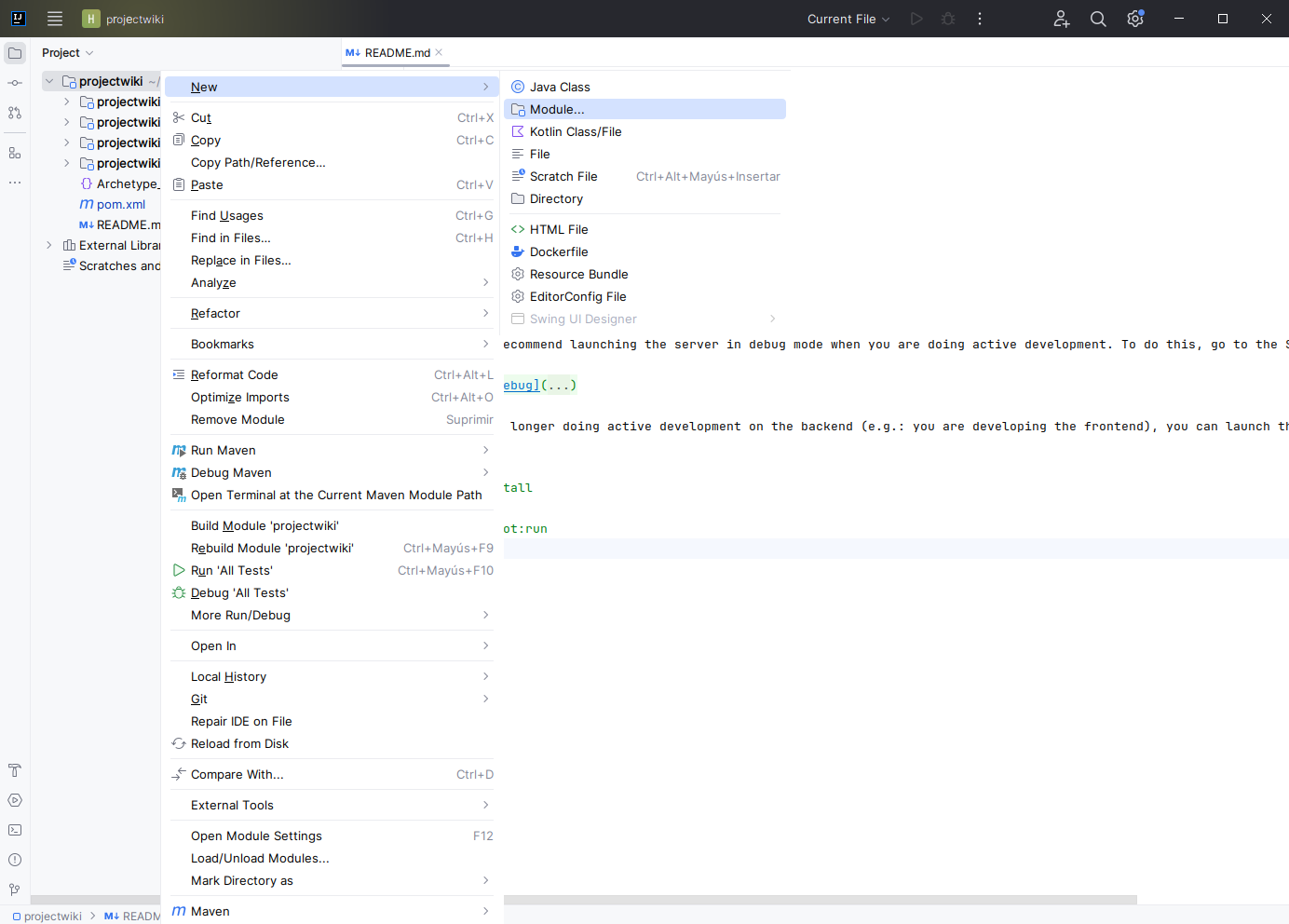
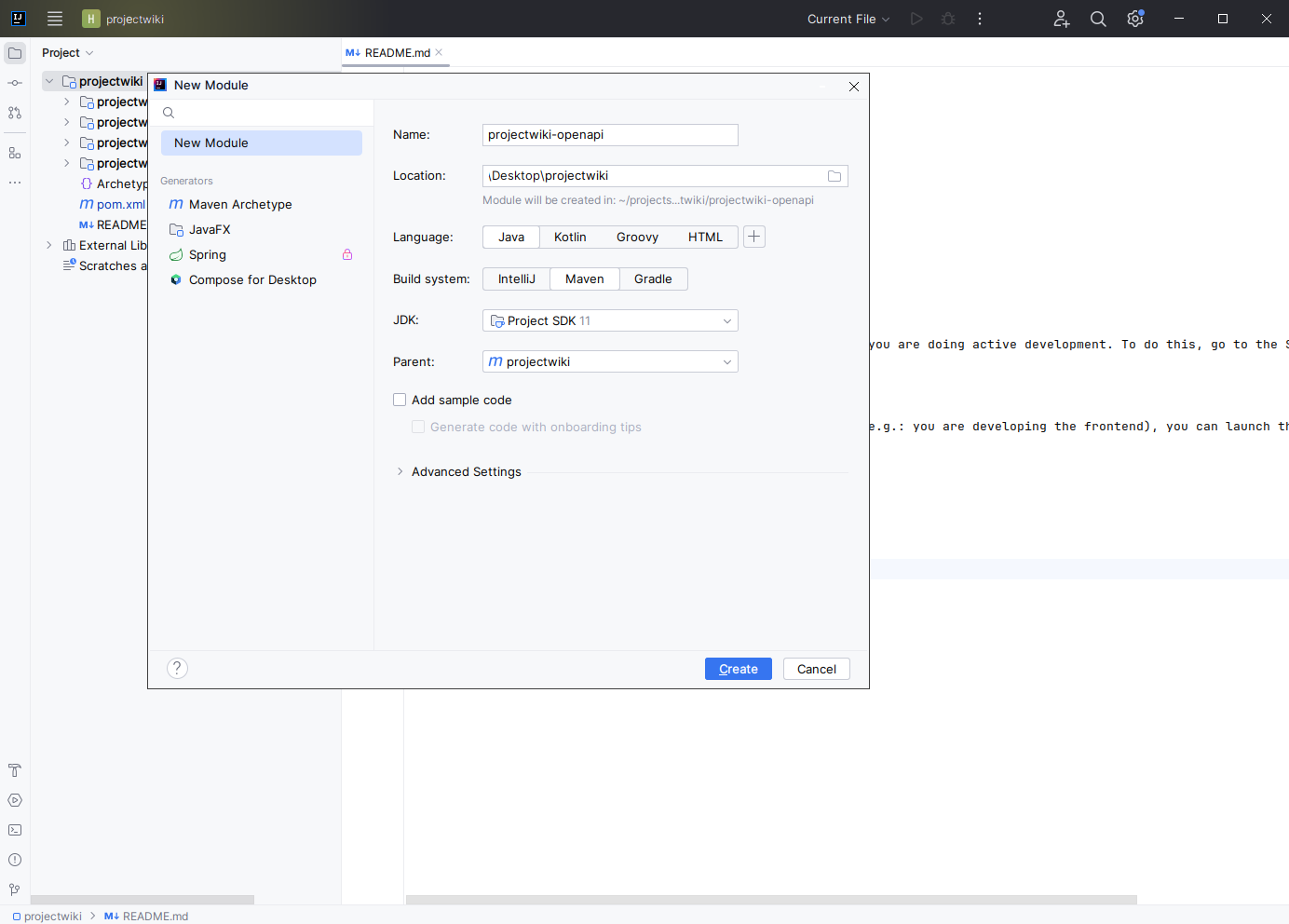
Add the dependencies to the project
In the main pom.xml we need to add the new module and the Swagger dependencies:
pom.xml
...
<properties>
...
<swagger-annotations.version>1.6.2</swagger-annotations.version>
</properties>
<dependencyManagement>
<dependencies>
...
<dependency>
<groupId>com.ontimize</groupId>
<artifactId>projectwiki-openapi</artifactId>
<version>1.0.0-SNAPSHOT</version>
</dependency>
<dependency>
<groupId>io.swagger</groupId>
<artifactId>swagger-annotations</artifactId>
<version>${swagger-annotations.version}</version>
</dependency>
</dependencies>
</dependencyManagement>
...
<modules>
<module>projectwiki-api</module>
<module>projectwiki-openapi</module>
<module>projectwiki-model</module>
<module>projectwiki-ws</module>
<module>projectwiki-boot</module>
</modules>
...- ontimize-examples
- projectwiki-api
- src
- main
- java
- com
- ontimize
- projectwiki
- api
- core
- service
- IUserService.java
- service
- core
- api
- projectwiki
- ontimize
- com
- java
- main
- pom.xml
- src
- projectwiki-boot
- src
- main
- java
- com
- ontimize
- projectwiki
- ServerApplication.java
- projectwiki
- ontimize
- com
- resources
- java
- main
- pom.xml
- src
- projectwiki-model
- src
- main
- db
- templateDB.txt
- java
- com
- ontimize
- projectwiki
- model
- core
- dao
- UserDao.java
- UserRoleDao.java
- service
- UserService.java
- dao
- core
- model
- projectwiki
- ontimize
- com
- resources
- dao
- placeholders.properties
- UserDao.xml
- UserRoleDao.xml
- dao
- db
- main
- pom.xml
- src
- projectwiki-openapi
- src
- main
- resources
- main
- pom.xml
- src
- projectwiki-ws
- src
- main
- java
- com
- ontimize
- projectwiki
- ws
- core
- rest
- MainRestController.java
- TestRestController.java
- UserRestController.java
- rest
- core
- ws
- projectwiki
- ontimize
- com
- java
- main
- pom.xml
- src
- .gitignore
- pom.xml
- README.md
- projectwiki-api
Add the dependencies to the OpenAPI module
In the pom.xml of the OpenAPI module we need to add the following dependencies:
pom.xml
...
<dependencies>
...
<dependency>
<groupId>com.ontimize.jee</groupId>
<artifactId>ontimize-jee-server-rest</artifactId>
</dependency>
<dependency>
<groupId>io.swagger</groupId>
<artifactId>swagger-annotations</artifactId>
</dependency>
<dependency>
<groupId>javax.annotation</groupId>
<artifactId>javax.annotation-api</artifactId>
</dependency>
<dependency>
<groupId>org.springframework.boot</groupId>
<artifactId>spring-boot-starter-validation</artifactId>
</dependency>
</dependencies>
...- ontimize-examples
- projectwiki-api
- src
- main
- java
- com
- ontimize
- projectwiki
- api
- core
- service
- IUserService.java
- service
- core
- api
- projectwiki
- ontimize
- com
- java
- main
- pom.xml
- src
- projectwiki-boot
- src
- main
- java
- com
- ontimize
- projectwiki
- ServerApplication.java
- projectwiki
- ontimize
- com
- resources
- application.yml
- java
- main
- pom.xml
- src
- projectwiki-model
- src
- main
- db
- templateDB.txt
- java
- com
- ontimize
- projectwiki
- model
- core
- dao
- UserDao.java
- UserRoleDao.java
- service
- UserService.java
- dao
- core
- model
- projectwiki
- ontimize
- com
- resources
- dao
- placeholders.properties
- UserDao.xml
- UserRoleDao.xml
- dao
- db
- main
- pom.xml
- src
- projectwiki-openapi
- src
- main
- resources
- main
- pom.xml
- src
- projectwiki-ws
- src
- main
- java
- com
- ontimize
- projectwiki
- ws
- core
- rest
- MainRestController.java
- TestRestController.java
- UserRestController.java
- rest
- core
- ws
- projectwiki
- ontimize
- com
- java
- main
- pom.xml
- src
- .gitignore
- pom.xml
- README.md
- projectwiki-api
Add the API definition
Following the OpenAPI specification we will create the definition for the test controller (More information in this link):
openapi-rest.yml
openapi: 3.0.3
info:
title: projectwiki API
version: '1.0'
description: The projectwiki API
servers:
- url: '/'
description: Localhost
paths:
/users/user:
post:
tags:
- Users
summary: Inserts a user.
description: >
This resource represents a user in the system.
x-restcontroller: orestcontroller
requestBody:
required: true
content:
application/json:
schema:
$ref: '#/components/schemas/InsertParameter'
examples:
Laura Bugle:
value:
data:
USER_: 'laura'
PASSWORD: '1432'
NAME: 'Laura'
SURNAME: 'Bugle'
EMAIL: 'laurabugle@gmail.com'
NIF: '11111111H'
USERBLOCKED: '2016-09-19T12:00:00Z'
LASTPASSWORDUPDATE: '2021-06-01T12:00:00'
FIRSTLOGIN: true
sqltypes:
USER_: 12
PASSWORD: 12
NAME: 12
SURNAME: 12
EMAIL: 12
NIF: 12
USERBLOCKED: 93
LASTPASSWORDUPDATE: 93
FIRSTLOGIN: 16
responses:
'200':
$ref: '#/components/responses/EntityResult'
'400':
$ref: '#/components/responses/BadRequest'
'401':
$ref: '#/components/responses/Unauthorized'
'404':
$ref: '#/components/responses/NotFound'
default:
$ref: '#/components/responses/Unexpected'
get:
tags:
- Users
summary: Returns a list of users.
description: >
This resource represents a list of users in the system.
x-restcontroller: orestcontroller
parameters:
- in: query
name: filter
description: Filter
schema:
type: string
required: false
examples:
user_:
value: 'USER_=laura'
password:
value: 'PASSWORD=1432'
name:
value: 'NAME=Laura'
surname:
value: 'SURNAME=Bugle'
email:
value: 'EMAIL=laurabugle@gmail.com'
nif:
value: 'NIF=11111111H'
- in: query
name: columns
description: Columns
required: false
schema:
type: string
example: USER_,PASSWORD,NAME,SURNAME,EMAIL,NIF,USERBLOCKED,LASTPASSWORDUPDATE,FIRSTLOGIN
responses:
'200':
$ref: '#/components/responses/EntityResult'
'400':
$ref: '#/components/responses/BadRequest'
'401':
$ref: '#/components/responses/Unauthorized'
'404':
$ref: '#/components/responses/NotFound'
default:
$ref: '#/components/responses/Unexpected'
put:
tags:
- Users
summary: Updates a user.
description: >
This resource represents a user in the system.
x-restcontroller: orestcontroller
requestBody:
required: true
content:
application/json:
schema:
$ref: '#/components/schemas/UpdateParameter'
examples:
pasword:
value:
data:
PASSWORD: 'mT765HkqjY_34:76l'
filter:
USER_: 'laura'
sqltypes:
USER_: 12
email:
value:
data:
EMAIL: 'laura.bugle@gmail.com'
filter:
USER_: 'laura'
sqltypes:
USER_: 12
responses:
'200':
$ref: '#/components/responses/EntityResult'
'400':
$ref: '#/components/responses/BadRequest'
'401':
$ref: '#/components/responses/Unauthorized'
'404':
$ref: '#/components/responses/NotFound'
default:
$ref: '#/components/responses/Unexpected'
delete:
tags:
- Users
summary: Deletes a user.
description: >
This resource represents a user in the system.
x-restcontroller: orestcontroller
requestBody:
required: true
content:
application/json:
schema:
$ref: '#/components/schemas/DeleteParameter'
examples:
userid:
value:
filter:
USER_: 'laura'
sqltypes:
USER_: 12
responses:
'200':
$ref: '#/components/responses/EntityResult'
'400':
$ref: '#/components/responses/BadRequest'
'401':
$ref: '#/components/responses/Unauthorized'
'404':
$ref: '#/components/responses/NotFound'
default:
$ref: '#/components/responses/Unexpected'
/users/user/search:
post:
tags:
- Users
summary: Searches and returns a list of users.
description: >
This resource represents a list of users in the system.
x-restcontroller: orestcontroller
requestBody:
content:
application/json:
schema:
$ref: '#/components/schemas/QueryParameter'
examples:
surname:
value:
filter:
SURNAME: 'Bugle'
columns:
- USER_
- PASSWORD
- NAME
- SURNAME
- EMAIL
- NIF
- USERBLOCKED
- LASTPASSWORDUPDATE
- FIRSTLOGIN
sqltypes:
SURNAME: 12
responses:
'200':
$ref: '#/components/responses/EntityResult'
'400':
$ref: '#/components/responses/BadRequest'
'401':
$ref: '#/components/responses/Unauthorized'
'404':
$ref: '#/components/responses/NotFound'
default:
$ref: '#/components/responses/Unexpected'
/users/login:
post:
operationId: login
tags:
- Users
summary: Validates the current session.
description: >
This resource represents a session in the system.
x-hasparentpath: true
responses:
'200':
$ref: '#/components/responses/EntityResult'
'400':
$ref: '#/components/responses/BadRequest'
'401':
$ref: '#/components/responses/Unauthorized'
'404':
$ref: '#/components/responses/NotFound'
default:
$ref: '#/components/responses/Unexpected'
components:
responses:
EntityResult:
description: OK
content:
application/json:
schema:
$ref: '#/components/schemas/EntityResult'
BadRequest:
description: Bad request
NotFound:
description: Not found
Unauthorized:
description: Unauthorized
Unexpected:
description: Unexpected error
schemas:
DeleteParameter:
type: object
properties:
filter:
description: Filter
type: object
additionalProperties:
type: string
sqltypes:
description: SQL types
type: object
additionalProperties:
type: string
EntityResult:
type: object
properties:
type:
description: Type
type: integer
code:
description: Code
type: integer
message:
description: Message
type: string
details:
description: Details
type: string
messageParameter:
description: Message parameter
type: array
items:
type: object
compressionLevel:
description: Compression level
type: integer
compressionThreshold:
description: Compression threshold
type: integer
columnsSQLTypes:
description: Columns SQL types
type: object
additionalProperties:
type: integer
operationId:
description: Operation Id
type: string
InsertParameter:
type: object
properties:
data:
description: Data
type: object
additionalProperties:
type: string
sqltypes:
description: SQL types
type: object
additionalProperties:
type: string
QueryParameter:
type: object
properties:
filter:
description: Filter
type: object
additionalProperties:
type: string
columns:
description: Columns
type: array
items:
type: string
sqltypes:
description: SQL types
type: object
additionalProperties:
type: string
UpdateParameter:
type: object
properties:
data:
description: Data
type: object
additionalProperties:
type: string
filter:
description: Filter
type: object
additionalProperties:
type: string
sqltypes:
description: SQL types
type: object
additionalProperties:
type: string
securitySchemes:
BasicAuth:
type: http
scheme: basic
security:
- BasicAuth: []- ontimize-examples
- projectwiki-api
- src
- main
- java
- com
- ontimize
- projectwiki
- api
- core
- service
- IUserService.java
- service
- core
- api
- projectwiki
- ontimize
- com
- java
- main
- pom.xml
- src
- projectwiki-boot
- src
- main
- java
- com
- ontimize
- projectwiki
- ServerApplication.java
- projectwiki
- ontimize
- com
- resources
- application.yml
- java
- main
- pom.xml
- src
- projectwiki-model
- src
- main
- db
- templateDB.txt
- java
- com
- ontimize
- projectwiki
- model
- core
- dao
- UserDao.java
- UserRoleDao.java
- service
- UserService.java
- dao
- core
- model
- projectwiki
- ontimize
- com
- resources
- dao
- placeholders.properties
- UserDao.xml
- UserRoleDao.xml
- dao
- db
- main
- pom.xml
- src
- projectwiki-openapi
- src
- main
- resources
- public
- restapi
- openapi-rest.yml
- restapi
- public
- resources
- main
- pom.xml
- src
- projectwiki-ws
- src
- main
- java
- com
- ontimize
- projectwiki
- ws
- core
- rest
- MainRestController.java
- TestRestController.java
- UserRestController.java
- rest
- core
- ws
- projectwiki
- ontimize
- com
- java
- main
- pom.xml
- src
- .gitignore
- pom.xml
- README.md
- projectwiki-api
Configure the OpenAPI system
This functionality can be enabled by creating the marker file marker-ws-ontimize-openapi-generator in the src/main/ontimize folder on the OpenAPI module. This file should only exist and be empty.
To comply with the project structure, we will generate the interfaces and the models in the package com.ontimize.projectwiki.openapi.core. Also, we will enable the bean validation functionality.
We can configure these functionalities adding the following properties it in the pom.xml file of the OpenAPI module (More information in this link).
pom.xml
...
<properties>
...
<ontimize.openapi.generator.maven.plugin.packageName>com.ontimize.projectwiki.openapi.core.service</ontimize.openapi.generator.maven.plugin.packageName>
<ontimize.openapi.generator.maven.plugin.modelPackageName>com.ontimize.projectwiki.openapi.core.dto</ontimize.openapi.generator.maven.plugin.modelPackageName>
<ontimize.openapi.generator.maven.plugin.useBeanValidation>true</ontimize.openapi.generator.maven.plugin.useBeanValidation>
</properties>
...- ontimize-examples
- projectwiki-api
- src
- main
- java
- com
- ontimize
- projectwiki
- api
- core
- service
- IUserService.java
- service
- core
- api
- projectwiki
- ontimize
- com
- java
- main
- pom.xml
- src
- projectwiki-boot
- src
- main
- java
- com
- ontimize
- projectwiki
- ServerApplication.java
- projectwiki
- ontimize
- com
- resources
- application.yml
- java
- main
- pom.xml
- src
- projectwiki-model
- src
- main
- db
- templateDB.txt
- java
- com
- ontimize
- projectwiki
- model
- core
- dao
- UserDao.java
- UserRoleDao.java
- service
- UserService.java
- dao
- core
- model
- projectwiki
- ontimize
- com
- resources
- dao
- placeholders.properties
- UserDao.xml
- UserRoleDao.xml
- dao
- db
- main
- pom.xml
- src
- projectwiki-openapi
- src
- main
- ontimize
- marker-ws-ontimize-openapi-generator
- resources
- public
- restapi
- openapi-rest.yml
- restapi
- public
- ontimize
- main
- pom.xml
- src
- projectwiki-ws
- src
- main
- java
- com
- ontimize
- projectwiki
- ws
- core
- rest
- MainRestController.java
- TestRestController.java
- UserRestController.java
- rest
- core
- ws
- projectwiki
- ontimize
- com
- java
- main
- pom.xml
- src
- .gitignore
- pom.xml
- README.md
- projectwiki-api
Generate the interfaces
Now, we need to build the project to generate the interfaces and models, these interfaces will be placed in the target folder of the OpenAPI module.
IUsersApi.java
package com.ontimize.projectwiki.openapi.core.service;
import org.springframework.http.ResponseEntity;
import org.springframework.web.bind.annotation.*;
import org.springframework.validation.annotation.Validated;
import javax.validation.Valid;
import javax.validation.constraints.*;
@Validated
public interface IUsersApi {
/**
* Deletes a user.
* This resource represents a user in the system.
* @param name (required)
* @param deleteParameter (required)
* @return com.ontimize.jee.common.dto.EntityResult
*
* This interface must be implemented on orestcontroller based classes.
* Path: /users/user
*/
public ResponseEntity<com.ontimize.jee.common.dto.EntityResult> delete(String name, com.ontimize.jee.server.rest.DeleteParameter deleteParameter);
/**
* Inserts a user.
* This resource represents a user in the system.
* @param name (required)
* @param insertParameter (required)
* @return com.ontimize.jee.common.dto.EntityResult
*
* This interface must be implemented on orestcontroller based classes.
* Path: /users/user
*/
public ResponseEntity<com.ontimize.jee.common.dto.EntityResult> insert(String name, com.ontimize.jee.server.rest.InsertParameter insertParameter);
/**
* Validates the current session.
* This resource represents a session in the system.
* @return com.ontimize.jee.common.dto.EntityResult
*
*/
@RequestMapping(path = "/login", method = RequestMethod.POST,
produces = { "application/json" })
public ResponseEntity<com.ontimize.jee.common.dto.EntityResult> login();
/**
* Returns a list of users.
* This resource represents a list of users in the system.
* @param name (required)
* @param filter Filter (optional)
* @param columns Columns (optional)
* @return com.ontimize.jee.common.dto.EntityResult
*
* This interface must be implemented on orestcontroller based classes.
* Path: /users/user
*/
public ResponseEntity<com.ontimize.jee.common.dto.EntityResult> query(String name, String filter, String columns);
/**
* Searches and returns a list of users.
* This resource represents a list of users in the system.
* @param name (required)
* @param queryParameter (optional)
* @return com.ontimize.jee.common.dto.EntityResult
*
* This interface must be implemented on orestcontroller based classes.
* Path: /users/user/search
*/
public ResponseEntity<com.ontimize.jee.common.dto.EntityResult> query(String name, com.ontimize.jee.server.rest.QueryParameter queryParameter) throws Exception;
/**
* Updates a user.
* This resource represents a user in the system.
* @param name (required)
* @param updateParameter (required)
* @return com.ontimize.jee.common.dto.EntityResult
*
* This interface must be implemented on orestcontroller based classes.
* Path: /users/user
*/
public ResponseEntity<com.ontimize.jee.common.dto.EntityResult> update(String name, com.ontimize.jee.server.rest.UpdateParameter updateParameter);
}- ontimize-examples
- projectwiki-api
- src
- main
- java
- com
- ontimize
- projectwiki
- api
- core
- service
- IUserService.java
- service
- core
- api
- projectwiki
- ontimize
- com
- java
- main
- pom.xml
- src
- projectwiki-boot
- src
- main
- java
- com
- ontimize
- projectwiki
- ServerApplication.java
- projectwiki
- ontimize
- com
- resources
- application.yml
- java
- main
- pom.xml
- src
- projectwiki-model
- src
- main
- db
- templateDB.txt
- java
- com
- ontimize
- projectwiki
- model
- core
- dao
- UserDao.java
- UserRoleDao.java
- service
- UserService.java
- dao
- core
- model
- projectwiki
- ontimize
- com
- resources
- dao
- placeholders.properties
- UserDao.xml
- UserRoleDao.xml
- dao
- db
- main
- pom.xml
- src
- projectwiki-openapi
- src
- main
- resources
- main
- target
- generated-sources
- java
- com
- ontimize
- projectwiki
- openapi
- core
- service
- IUsersApi.java
- service
- core
- openapi
- projectwiki
- ontimize
- com
- java
- generated-sources
- pom.xml
- src
- projectwiki-ws
- src
- main
- java
- com
- ontimize
- projectwiki
- ws
- core
- rest
- MainRestController.java
- TestRestController.java
- UserRestController.java
- rest
- core
- ws
- projectwiki
- ontimize
- com
- java
- main
- pom.xml
- src
- .gitignore
- pom.xml
- README.md
- projectwiki-api
Implements the generated interfaces on the web services module
Once the interfaces have been generated, we need to add the OpenAPI module dependency to the web services module and implement the interface on the REST controller.
The request mapping annotations are declared on the generated interface and should not be declared again on the controller.
pom.xml
...
<dependencies>
<dependency>
<groupId>com.ontimize</groupId>
<artifactId>projectwiki-openapi</artifactId>
</dependency>
...
<dependencies>
...UserRestController.java
package com.ontimize.projectwiki.ws.core.rest;
import com.ontimize.projectwiki.openapi.core.service.IUsersApi;
import org.springframework.beans.factory.annotation.Autowired;
import org.springframework.http.HttpStatus;
//import org.springframework.http.MediaType;
import org.springframework.http.ResponseEntity;
import org.springframework.web.bind.annotation.RequestMapping;
//import org.springframework.web.bind.annotation.RequestMethod;
import org.springframework.web.bind.annotation.RestController;
import com.ontimize.projectwiki.api.core.service.IUserService;
import com.ontimize.jee.common.dto.EntityResult;
import com.ontimize.jee.server.rest.ORestController;
@RestController
@RequestMapping("/users")
public class UserRestController extends ORestController<IUserService> implements IUsersApi {
@Autowired
private IUserService userSrv;
@Override
public IUserService getService() {
return this.userSrv;
}
/* @RequestMapping(
value = "/login",
method = RequestMethod.POST,
produces = MediaType.APPLICATION_JSON_VALUE) */
@Override
public ResponseEntity<EntityResult> login() {
return new ResponseEntity<>(HttpStatus.OK);
}
}- ontimize-examples
- projectwiki-api
- src
- main
- java
- com
- ontimize
- projectwiki
- api
- core
- service
- IUserService.java
- service
- core
- api
- projectwiki
- ontimize
- com
- java
- main
- pom.xml
- src
- projectwiki-boot
- src
- main
- java
- com
- ontimize
- projectwiki
- ServerApplication.java
- projectwiki
- ontimize
- com
- resources
- application.yml
- java
- main
- pom.xml
- src
- projectwiki-model
- src
- main
- db
- templateDB.txt
- java
- com
- ontimize
- projectwiki
- model
- core
- dao
- UserDao.java
- UserRoleDao.java
- service
- UserService.java
- dao
- core
- model
- projectwiki
- ontimize
- com
- resources
- dao
- placeholders.properties
- UserDao.xml
- UserRoleDao.xml
- dao
- db
- main
- pom.xml
- src
- projectwiki-openapi
- src
- main
- ontimize
- marker-ws-ontimize-openapi-generator
- resources
- ontimize
- main
- pom.xml
- src
- projectwiki-ws
- src
- main
- java
- com
- ontimize
- projectwiki
- ws
- core
- rest
- MainRestController.java
- TestRestController.java
- UserRestController.java
- rest
- core
- ws
- projectwiki
- ontimize
- com
- java
- main
- pom.xml
- src
- .gitignore
- pom.xml
- README.md
- projectwiki-api
Testing
To test this functionality we will use the Swagger tool provided by Ontimize.
Enable the Swagger User Interface
To enable the Swagger UI we will add the following property it in the pom.xml file of the OpenAPI module (More information in this link).
pom.xml
...
<properties>
...
<ontimize.openapi.swagger-ui.enabled>true</ontimize.openapi.swagger-ui.enabled>
</properties>
...- ontimize-examples
- projectwiki-api
- src
- main
- java
- com
- ontimize
- projectwiki
- api
- core
- service
- IUserService.java
- service
- core
- api
- projectwiki
- ontimize
- com
- java
- main
- pom.xml
- src
- projectwiki-boot
- src
- main
- java
- com
- ontimize
- projectwiki
- ServerApplication.java
- projectwiki
- ontimize
- com
- resources
- application.yml
- java
- main
- pom.xml
- src
- projectwiki-model
- src
- main
- db
- templateDB.txt
- java
- com
- ontimize
- projectwiki
- model
- core
- dao
- UserDao.java
- UserRoleDao.java
- service
- UserService.java
- dao
- core
- model
- projectwiki
- ontimize
- com
- resources
- dao
- placeholders.properties
- UserDao.xml
- UserRoleDao.xml
- dao
- db
- main
- pom.xml
- src
- projectwiki-openapi
- src
- main
- ontimize
- marker-ws-ontimize-openapi-generator
- resources
- ontimize
- main
- pom.xml
- src
- projectwiki-ws
- src
- main
- java
- com
- ontimize
- projectwiki
- ws
- core
- rest
- MainRestController.java
- TestRestController.java
- UserRestController.java
- rest
- core
- ws
- projectwiki
- ontimize
- com
- java
- main
- pom.xml
- src
- .gitignore
- pom.xml
- README.md
- projectwiki-api
Redirect to the Swagger User Interface (Optional)
Now, we will add a custom index.html that will redirect to the Swagger UI when we open the application in the browser.
<!doctype html>
<html>
<head>
<meta charset="utf-8">
<title>projectwiki</title>
<link rel="icon" type="image/x-icon" href="favicon.ico">
<meta name="viewport" content="width=device-width, initial-scale=1">
<script type="application/javascript">
location.href = location.origin + "/swagger-ui/index.html";
</script>
</head>
<body>
</body>
</html>- ontimize-examples
- projectwiki-api
- src
- main
- java
- com
- ontimize
- projectwiki
- api
- core
- service
- IUserService.java
- service
- core
- api
- projectwiki
- ontimize
- com
- java
- main
- pom.xml
- src
- projectwiki-boot
- src
- main
- java
- com
- ontimize
- projectwiki
- ServerApplication.java
- projectwiki
- ontimize
- com
- resources
- public
- index.html
- application.yml
- public
- java
- main
- pom.xml
- src
- projectwiki-model
- src
- main
- db
- templateDB.txt
- java
- com
- ontimize
- projectwiki
- model
- core
- dao
- UserDao.java
- UserRoleDao.java
- service
- UserService.java
- dao
- core
- model
- projectwiki
- ontimize
- com
- resources
- dao
- placeholders.properties
- UserDao.xml
- UserRoleDao.xml
- dao
- db
- main
- pom.xml
- src
- projectwiki-openapi
- src
- main
- ontimize
- marker-ws-ontimize-openapi-generator
- resources
- ontimize
- main
- pom.xml
- src
- projectwiki-ws
- src
- main
- java
- com
- ontimize
- projectwiki
- ws
- core
- rest
- MainRestController.java
- TestRestController.java
- UserRestController.java
- rest
- core
- ws
- projectwiki
- ontimize
- com
- java
- main
- pom.xml
- src
- .gitignore
- pom.xml
- README.md
- projectwiki-api
Allow to access to the API specification and to the Swagger User Interface
The API specification and the Swagger UI must be accesible withouth authentication. To do this, we must provide them as static resources and exclude them from the list of protected paths.
application.yml
...
ontimize:
...
security:
...
ignore-paths: '/index.html,/restapi/**,/swagger-ui/**'
...
spring:
...
resources:
...
static-locations: classpath:/public/
...- ontimize-examples
- projectwiki-api
- src
- main
- java
- com
- ontimize
- projectwiki
- api
- core
- service
- IUserService.java
- service
- core
- api
- projectwiki
- ontimize
- com
- java
- main
- pom.xml
- src
- projectwiki-boot
- src
- main
- java
- com
- ontimize
- projectwiki
- ServerApplication.java
- projectwiki
- ontimize
- com
- resources
- public
- index.html
- application.yml
- public
- java
- main
- pom.xml
- src
- projectwiki-model
- src
- main
- db
- templateDB.txt
- java
- com
- ontimize
- projectwiki
- model
- core
- dao
- UserDao.java
- UserRoleDao.java
- service
- UserService.java
- dao
- core
- model
- projectwiki
- ontimize
- com
- resources
- dao
- placeholders.properties
- UserDao.xml
- UserRoleDao.xml
- dao
- db
- main
- pom.xml
- src
- projectwiki-openapi
- src
- main
- ontimize
- marker-ws-ontimize-openapi-generator
- resources
- ontimize
- main
- pom.xml
- src
- projectwiki-ws
- src
- main
- java
- com
- ontimize
- projectwiki
- ws
- core
- rest
- MainRestController.java
- TestRestController.java
- UserRestController.java
- rest
- core
- ws
- projectwiki
- ontimize
- com
- java
- main
- pom.xml
- src
- .gitignore
- pom.xml
- README.md
- projectwiki-api
Once the changes has been applied, we must built and run the project, then we can access to the application by opening a web browser and navigating to http://localhost:33333):
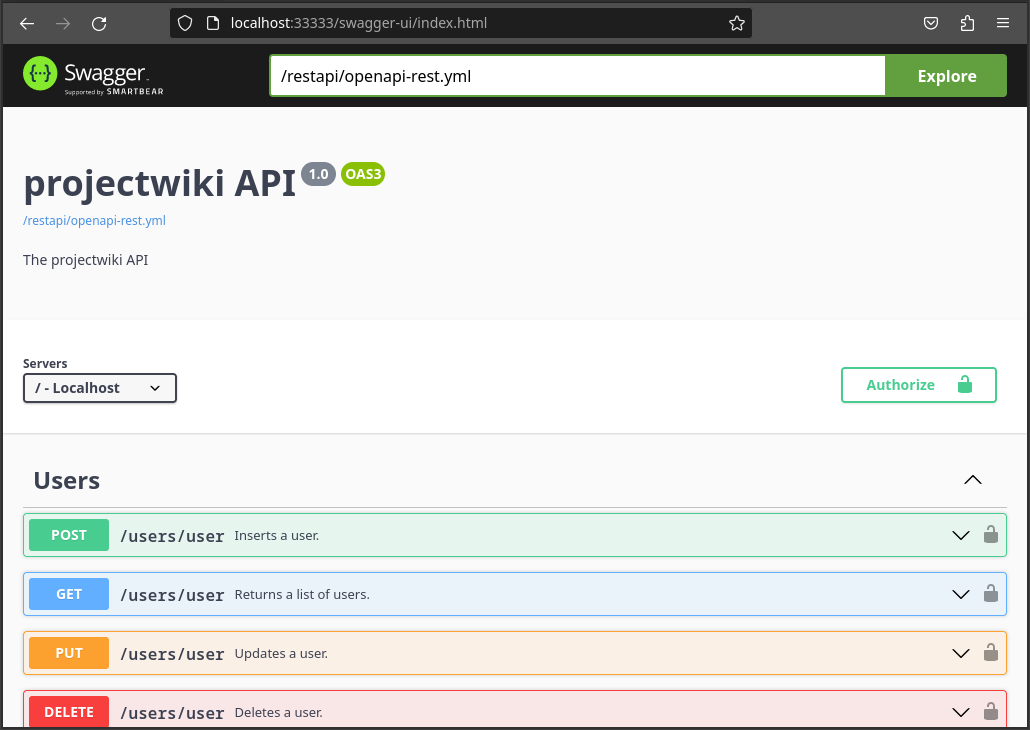
We must open the authorization dialog by clicking on the Authorize button, provide the credentials, click on the Authorize and the Close button.
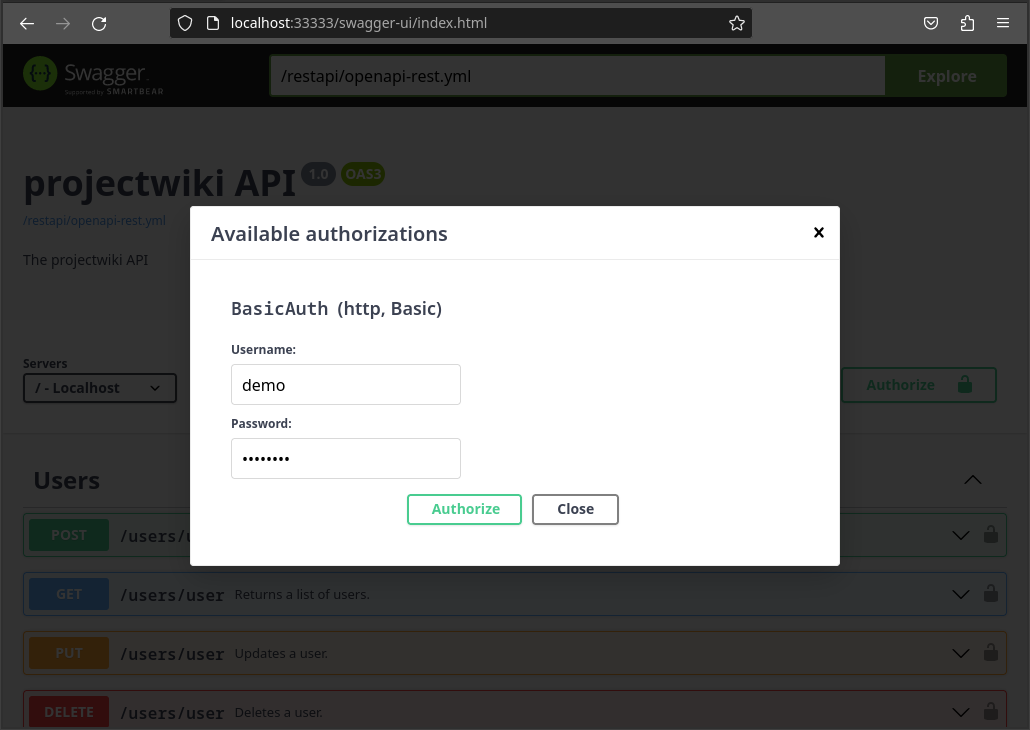
Now, we will insert a new user on the users table, to do this we will expand the insert section, click on the Try it out and the Execute buttons.
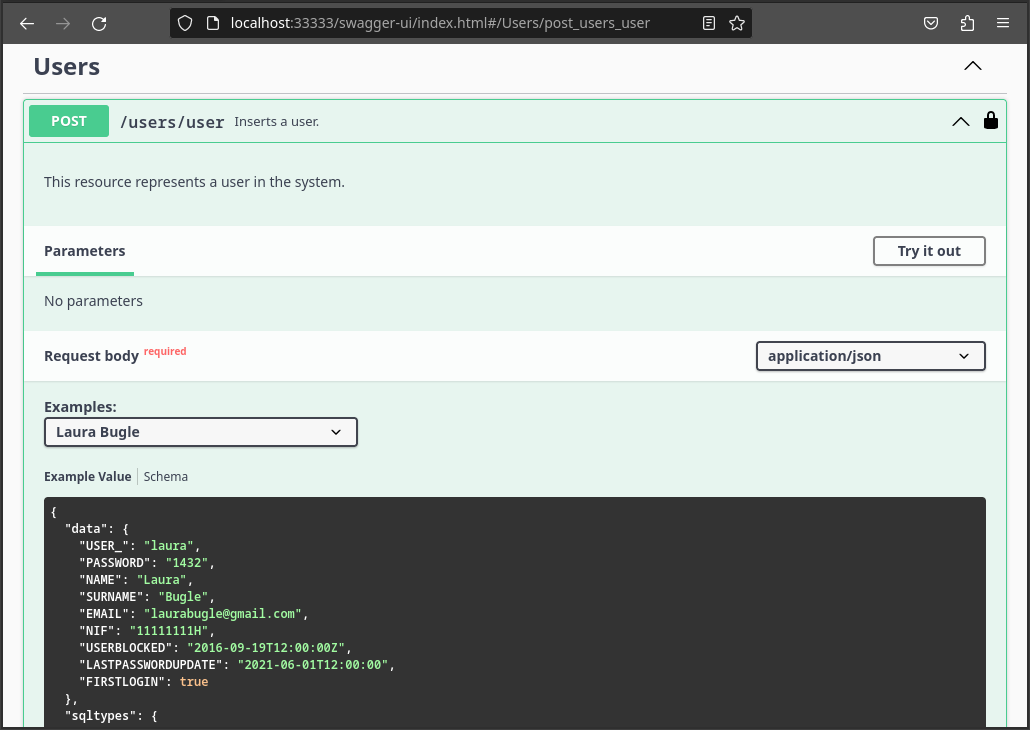
The Swagger UI will make the request to the API and will show that the operation was completed successfully.
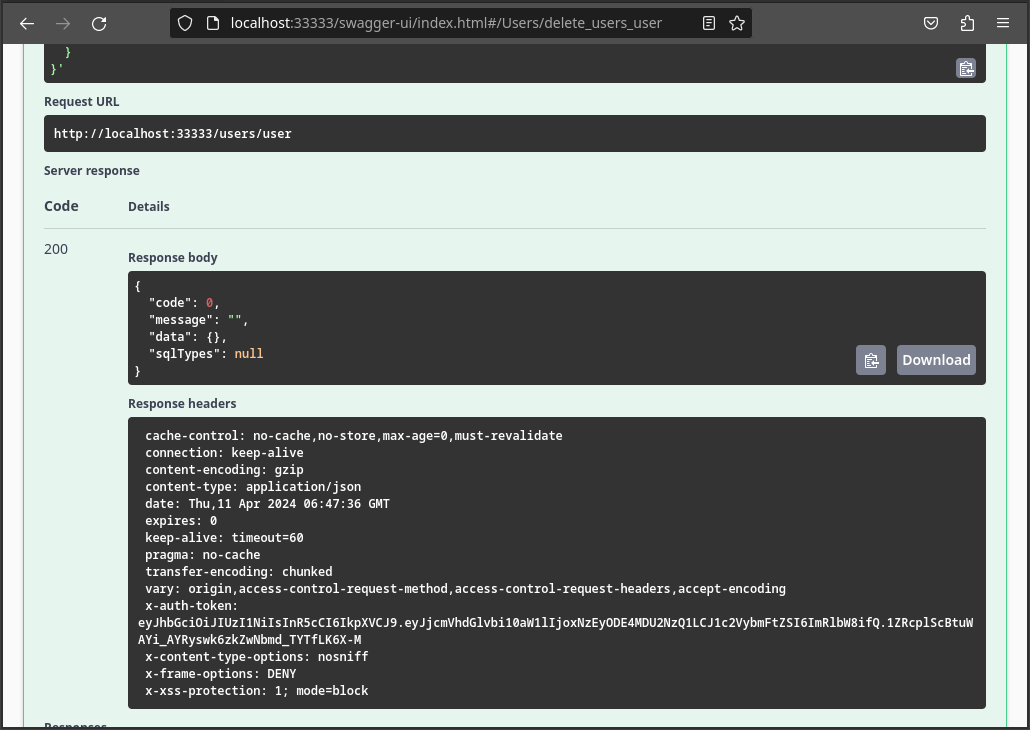
After the insertion, we will request the user info, to do this we will expand the query section, click on the Try it out and the Execute buttons.
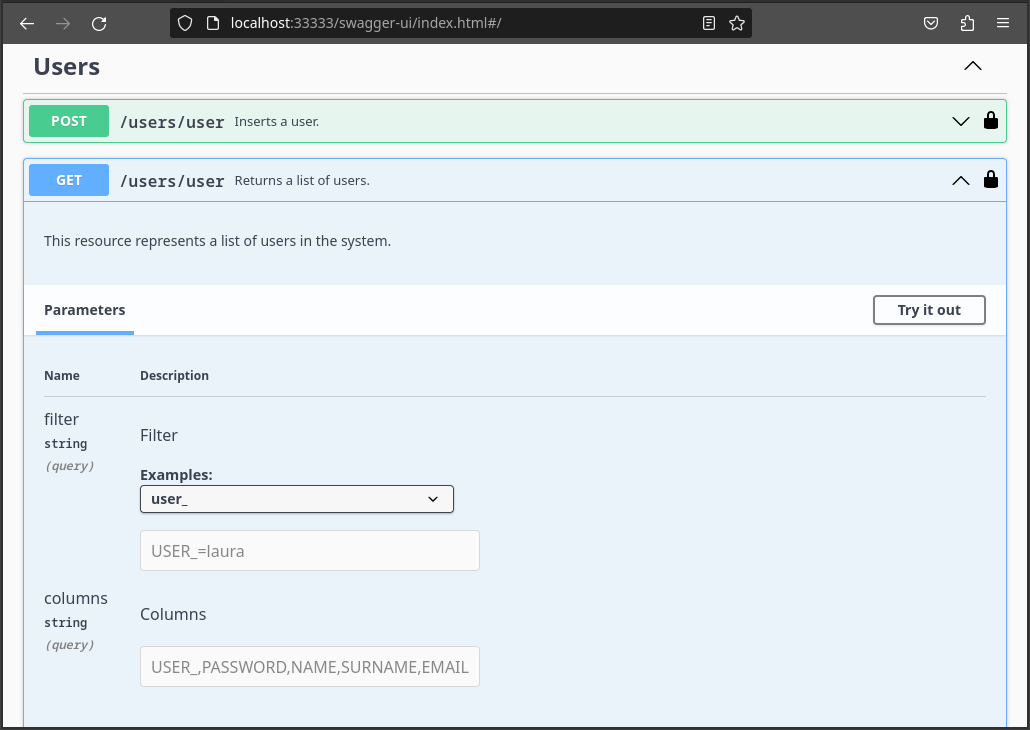
The Swagger UI will make the request to the API and will show the user info.
